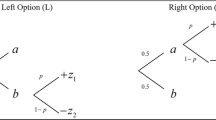Abstract
This paper reports the results of experiments designed to test the effect of experience on preferences for self-protection against low and high probability losses. Subjects gained experience by repeatedly making choices about whether or not to invest in a protective activity and then observing the result of their choice. Half of the subjects faced a low probability risk while the other half faced a higher probability risk with the severity of loss scaled down to hold expected value constant. Protection was more common against the high probability risk. Despite receiving full information about the risks in advance, most subjects made choices in response to prior outcomes. This led to a great deal of experimentation when losses were common (the high probability risk) but very little experimentation when losses were infrequent (the low probability risk).

Similar content being viewed by others
Notes
The third empirical regularity noted by Erev and Barron (2005) is loss aversion. Since all gambles in this paper are entirely in the loss domain, loss aversion cannot explain behavior in this paper’s experiments.
Only the low cost treatments played the fourth part.
References
Barron, G., & Erev, I. (2003). Small feedback-based decisions and their limited correspondence to description-based decisions. Journal of Behavioral Decision Making, 16, 215–233.
Bellemare, C., Krause, M., Kroger, S., & Zhang, C. (2005). Myopic loss aversion: Information feedback vs. investment flexibility. Economics Letters, 87, 319–324.
Browne, M. J., & Hoyt, R. E. (2000). The demand for flood insurance: Empirical evidence. Journal of Risk and Uncertainty, 20, 291–306.
Busemeyer, J. R., & Townsend, J. T. (1993). Decision field theory: A dynamic-cognitive approach to decision making in an uncertain environment. Psychological Review, 100, 432–459.
Chen, Y., & Corter, J. E. (2006). When mixed options are preferred in multiple-trial decisions. Journal of Behavioral Decision Making, 19, 17–42.
Ehrlich, I., & Becker, G. S. (1972). Market insurance, self-insurance, and self-protection. Journal of Political Economy, 80, 623–648.
Erev, I., & Barron, G. (2005). On adaptation, maximization, and reinforcement learning among cognitive strategies. Psychological Review, 112, 912–931.
Gneezy, U., & Potters, J. (1997). An experiment on risk taking and evaluation periods. The Quarterly Journal of Economics, 112, 631–645.
Hamilton, J. D., & Jorda, O. (2002). A model of the federal funds rate target. Journal of Political Economy, 110, 1135–1167.
Hertwig, R., Barron, G., Weber, E. U., & Erev, I. (2004). Decisions from experience and the effect of rare events in risky choice. Psychological Science, 15, 534–539.
Hertwig, R., & Erev, I. (2009). The description-experience gap in risky choice. Trends in Cognitive Sciences, 13, 517–523.
Jessup, R. K., Bishara, A. J., & Busemeyer, J. R. (2008). Feedback produces divergence from prospect theory in descriptive choice. Psychological Science, 19, 1015–1022.
Kahneman, D., & Tversky, A. (1979). Prospect theory: An analysis of decision under risk. Econometrica, 47, 263–291.
Keren, G. (1991). Additional tests of utility theory under unique and repeated conditions. Journal of Behavioral Decision Making, 4, 297–304.
Keren, G., & Wagenaar, W. A. (1987) Violation of utility theory in unique and repeated gambles. Journal of Experimental Psychology: Learning, Memory, and Cognition, 13, 387–391.
Kruse, J. B., & Thompson, M. A. (2003). Valuing low probability risk: survey and experimental evidence. Journal of Economic Behavior and Organization, 50, 495–505.
Kunreuther, H. (1978). Disaster insurance protection: Public policy lessons. New York: Wiley.
Kunreuther, H., Meyer, R., & Van den Bulte, C. (2004). Risk analysis for extreme events: Economic incentives for reducing future losses. Technical Report, National Institute of Standards and Technology.
Kunreuther, H., Novemsky, N., & Kahneman, D. (2001). Making low probabilities useful. Journal of Risk and Uncertainty, 23, 103–120.
Kunreuther, H., Onculer, A., & Slovic, P. (1998). Time insensitivity for protective investments. Journal of Risk and Uncertainty, 16, 279–299.
Prelec, D. (1998). The probability weighting function. Econometrica, 66, 497–527.
Samuelson, P. (1963). Risk and uncertainty: A fallacy of large numbers. Scientia, 98, 108–113.
Shogren, J. F. (1990). The impact of self-protection and self-insurance on individual response to risk. Journal of Risk and Uncertainty, 3, 191–204.
Thaler, R. H., Tversky, A., Kahneman, D., & Schwartz, A. (1997). The effect of myopia and loss aversion on risk taking: An experimental test. The Quarterly Journal of Economics, 112, 647–661.
Tversky, A., & Kahneman, D. (1992). Advances in prospect theory: Cumulative representation of uncertainty. Journal of Risk and Uncertainty, 5, 297–323.
Viscusi, W. K. (1979a). Insurance and individual incentives in adaptive contexts. Econometrica, 47, 1195–1208.
Viscusi, W. K. (1979b). Employment hazards: An investigation of market performance. Cambridge: Harvard University Press.
Viscusi, W. K. (1989). Prospective reference theory: Toward an explanation of the paradoxes. Journal of Risk and Uncertainty, 2, 235–264.
Von Neumann, J., & Morgenstern, O. (1947). Theory of games and economic behavior. Princeton: Princeton University Press.
Yechiam, E., & Busemeyer, J. R. (2006). The effect of foregone payoffs on underweighting small probability events. Journal of Behavioral Decision Making, 19, 1–16.
Acknowledgements
The author thanks Paan Jindapon, Jason Lepore, Eric Fisher, Daniel Friedman, the Journal of Risk and Uncertainty Editorial Board, and an anonymous reviewer for helpful comments. Thanks to the Orfalea College of Business for financial support.
Author information
Authors and Affiliations
Corresponding author
Rights and permissions
About this article
Cite this article
Shafran, A.P. Self-protection against repeated low probability risks. J Risk Uncertain 42, 263–285 (2011). https://doi.org/10.1007/s11166-011-9116-2
Published:
Issue Date:
DOI: https://doi.org/10.1007/s11166-011-9116-2




